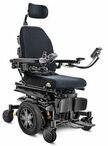Traveling with ALS |
|
|
An ALS diagnosis does not have to stop you from traveling. If you want to visit friends or embark on a new adventure, plan ahead and take that trip. It may take more planning, time, and patience, but that doesn't mean you shouldn't get out and enjoy yourselves.
|
|
Take a road trip
If you don't have a car or van that is suitable for longer trips, you can always rent a van from a company like Wheelchair Getaways. It is just like renting a car, which gives you the freedom to go on vacation, explore a new city, or just spend a weekend away. Wheelchair Getaways does not provide a driver, so you will need a licensed driver in your party. They offer daily, weekly, monthly, and long-term handicap-accessible van rentals at locations across the country.
Bucket List TravelAfter his ALS diagnosis, Ed and his wife Dolly "chose to live—and live large." They traveled throughout the U.S. and Europe and took an unforgettable trip to Patagonia, Argentina. Dolly writes about the challenges and rewards of traveling with ALS. Read article
|
Travel by Plane
As long as you can ride in a standard airplane seat for the duration of the flight, you can fly on commercial airlines. It is fine if you need to be transferred from your wheelchair into the seat. The airline and airport staff should be helpful and accommodating.
Here are some tips for a successful flight:
- Plan ahead. Traveling with a disability can be complicated, so make all arrangements well ahead of your travel day. If you are traveling with any medical or mobility device, contact the airline ahead of time to make sure it is approved. Also make any special travel assistance requests, including checking a scooter or power wheelchair.
- Fly with a companion. Depending on your physical needs, it is probably a good idea to travel with a trusted friend, relative, or caregiver. There are some things that flight attendants will be unable to do, such as helping lift or lower you from seat to wheelchair to toilet.
- Bring everything you need. Your medical and mobility devices do not count toward your checked luggage or carry-on limits. At either the ticket counter or departure gate, you can check scooters, non-collapsible wheelchairs, and other battery-powered wheelchairs. Items that don’t fit in the cabin that you don’t need during the flight may need to be checked. Assistive devices such as canes, walkers, BiPAPs, suction machines, cough assists, and comfort items like cushions, armrests, or footrests that fit into overhead and under-seat storage are allowed.
- Or, borrow equipment at your destination. If you prefer to travel without all of your equipment, talk with your local ALS organization. It may be possible—availability permitting—to borrow equipment from an ALS organization at your destination. That organization may also be able to help you coordinate with local companies for things like van rentals.
- Pack your prescriptions. If you have respiratory equipment or medications, travel with the prescriptions from your doctor.
- Coordinate travel to and from the plane. If you need travel assistance within the airports, schedule it ahead of time with the airline. Also, remind ticket agents and flight attendants on both ends of your flight.
- Have a plan for the airplane lavatory. You may need to relieve yourself during the flight. Plan for that scenario. Flight attendants can provide assistance to the lavatory door with an onboard wheelchair, but they cannot provide lift assistance in or out of the chair or small lavatory. Men might consider using a condom catheter for the flight.
- Get your in-flight devices pre-approved. If you need to use any electronic medical device during the flight—and it must be battery-operated—you must send in a physician consent form and give the airline at least 48 hours prior notice. You are required to bring any necessary, fully-charged batteries to power your device throughout the flight. You should not depend on the availability of a power outlet to support your device.
Flying with a Power WheelchairIf you are considering traveling by plane with your power wheelchair, you can find practical tips on our Traveling by Plane with Your Power Chair page.
|




